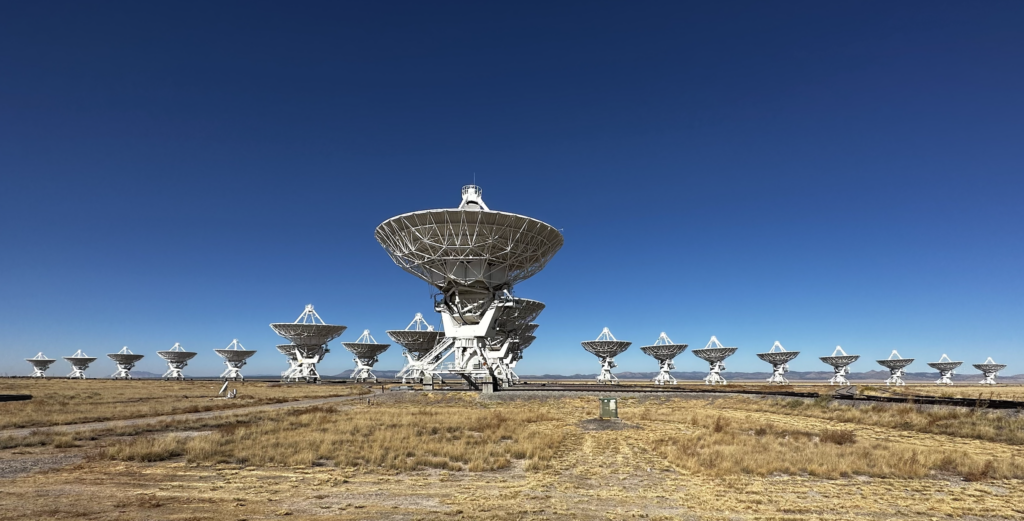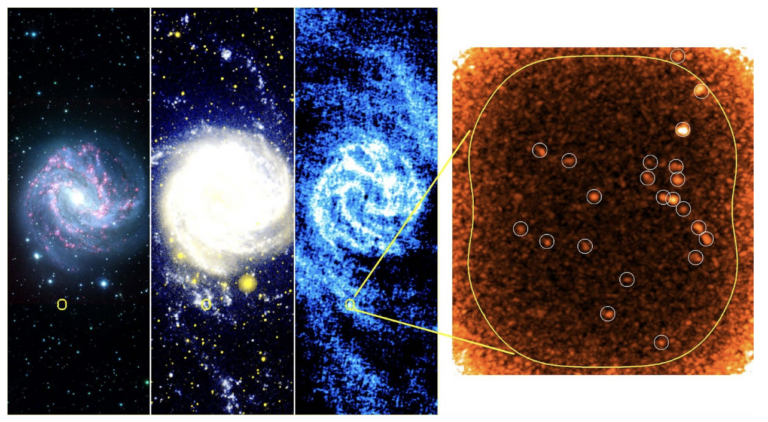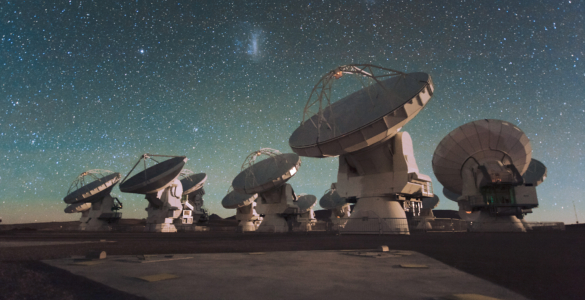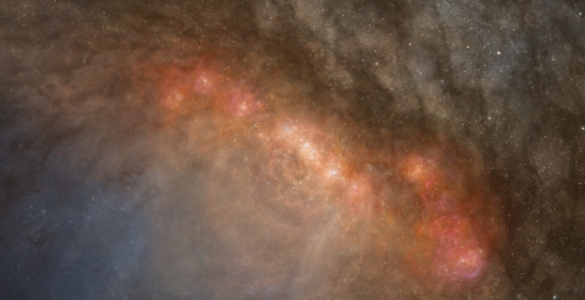An international team of astronomers has revealed mysterious star formation at the far edge of the galaxy M83. This research was presented today in a press conference at the 243rd meeting of the American Astronomical Society (AAS) in New Orleans, Louisiana.
The research used several instruments operated by the National Science Foundation’s National Radio Astronomy Observatory (NRAO), including the Atacama Large Millimeter/submillimeter Array (ALMA), the Karl G. Jansky Very Large Array (VLA), and the Green Bank Telescope (GBT), along with the National Astronomical Observatory of Japan’s (NAOJ) Subaru Telescope and the NASA Galaxy Evolution Explorer (GALEX).
Normally, new stars form as a result of diffuse atomic gas shrinking into concentrations of molecular gas, called molecular clouds, whose high density cores at their center trigger star formation. This process is common in the inner part of galaxies, but becomes increasingly rare toward galaxy outskirts.
A surprising number of very young stars are known to exist at the far edges of many galaxies, but scientists could not understand how and why these stars were made, because they could not pinpoint their formation sites. This research discovered 23 molecular clouds that showed a different type of star formation. The large bodies of these clouds were not visible like “normal” molecular clouds—only their star-forming dense cores, the “hearts” of the clouds, were observed. This discovery provides an important clue to understanding the physical processes that lead to star formation in general.
“The star formation at galaxy edges has been a nagging mystery since their discovery by the NASA GALEX satellite 18 years ago” said astronomer Jin Koda, of Stony Brook University, who led this research, “Previous searches for molecular clouds in this environment turned out unsuccessful.” David Thilker, of Johns Hopkins University, who originally discovered the star formation activity occurring in the outskirts of M83 and other galaxies, commented, “It has been gratifying to see the search for dense clouds associated with the outer disk finally come to fruition, revealing a characteristically different observational fingerprint for the molecular clouds.”
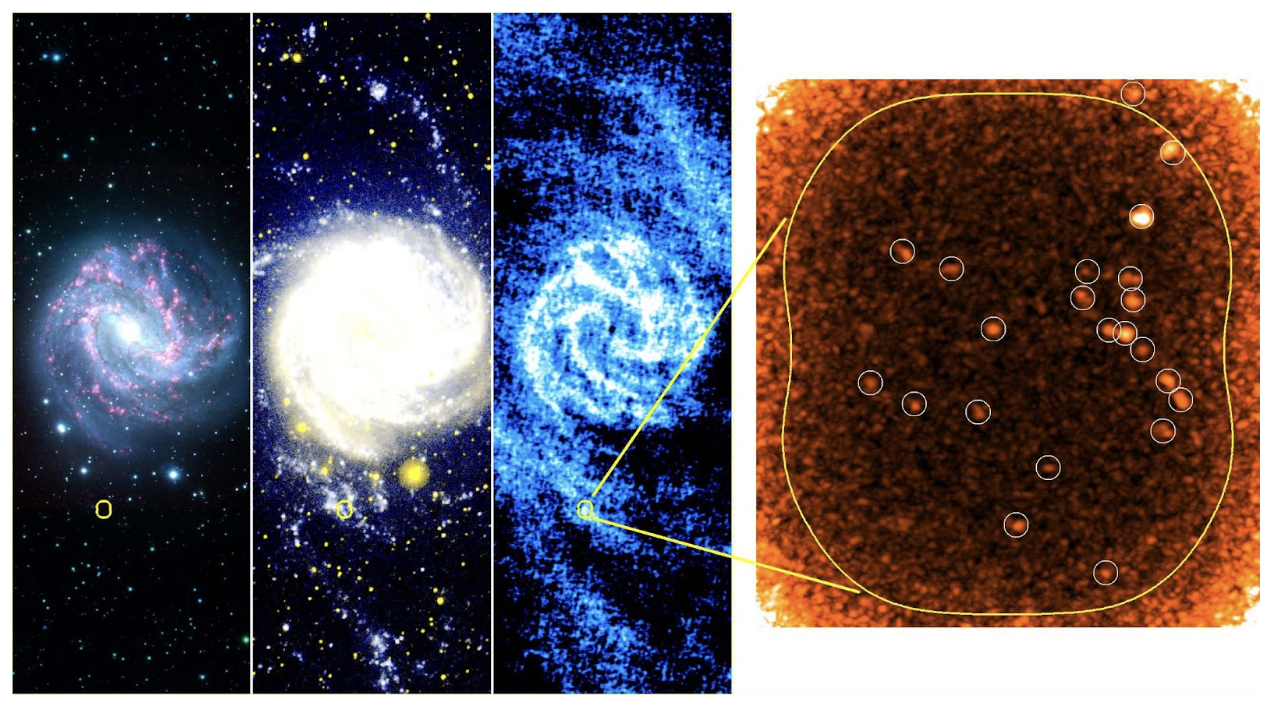
The revelation of these molecular clouds uncovered a link to a large reservoir of diffuse atomic gas, another discovery by this research. Normally, atomic gas condenses into dense molecular clouds, within which even denser cores develop and form stars. This process is in operation even at galaxy edges, but the conversion of this atomic gas to molecular clouds was not evident, for reasons that are yet unresolved.
Amanda Lee, who was an undergraduate student on Koda’s research team, processed GBT & VLA data for these findings. Through this, she discovered the atomic gas reservoir at the galaxy edge. “We still do not understand why this atomic gas does not efficiently become dense molecular clouds and form stars.” As often is the case in astronomy, pursuing answers to one mystery can often lead to another. “That’s why research in astronomy is exciting,” adds Lee, who is now pursuing her Ph.D. in astronomy at UMass Amherst.
Thilker added, “I am excited to see this new opportunity leveraged more broadly in the outer disk environment in order to gain a deeper insight for physical processes central to the inside-out growth of galaxies still happening in the current cosmic epoch.’
“When I started, I didn’t know what role my work would play. It was very exciting to see it contribute to the big picture of star formation,” said Lee.
Watch the press conference here.
About ALMA & NRAO
The Atacama Large Millimeter/submillimeter Array (ALMA), an international astronomy facility, is a partnership of the European Organisation for Astronomical Research in the Southern Hemisphere (ESO), the U.S. National Science Foundation (NSF) and the National Institutes of Natural Sciences (NINS) of Japan in cooperation with the Republic of Chile. ALMA is funded by ESO on behalf of its Member States, by NSF in cooperation with the National Research Council of Canada (NRC) and the Ministry of Science and Technology (MOST) and by NINS in cooperation with the Academia Sinica (AS) in Taiwan and the Korea Astronomy and Space Science Institute (KASI).
ALMA construction and operations are led by ESO on behalf of its Member States; by the National Radio Astronomy Observatory (NRAO), managed by Associated Universities, Inc. (AUI), on behalf of North America; and by the National Astronomical Observatory of Japan (NAOJ) on behalf of East Asia. The Joint ALMA Observatory (JAO) provides the unified leadership and management of the construction, commissioning and operation of ALMA.
NRAO is a facility of the National Science Foundation, operated under cooperative agreement by Associated Universities, Inc.
About Green Bank Observatory
The Green Bank Observatory is a major facility of the National Science Foundation and is operated by Associated Universities, Inc. The first national radio astronomy observatory in the US, it’s home to the 100-meter Green Bank Telescope, the largest fully-steerable radio telescope in the world.
###
Corrina Jaramillo Feldman, Public Information Officer – NRAO/VLA/ngVLA
cfeldman@nrao.edu
505-366-7267
Jill Malusky, NRAO & GBO News & Public Information Manager
jmalusky@nrao.edu
304-460-5608


